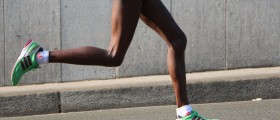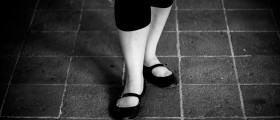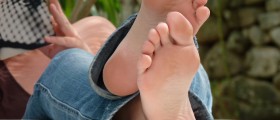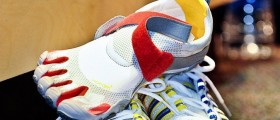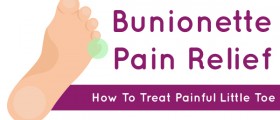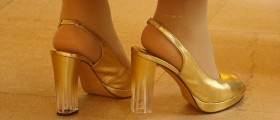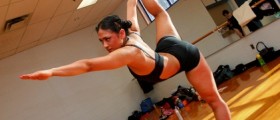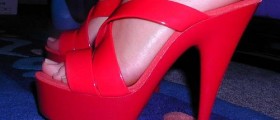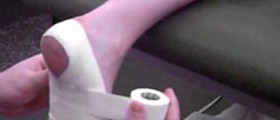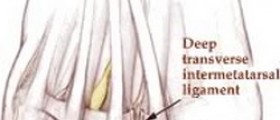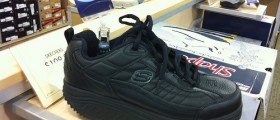This isn't one of those ballet positions is it? We wouldn't want Kat to get toe problems on top to the shin problems, now would we?
Swear to God, no. Learned this one in aerobics. I've had shin splints once and then started taking warm-ups more seriously. :)
Swear to God, no. Learned this one in aerobics. I've had shin splints once and then started taking warm-ups more seriously. :)
Loading...
The term shins pints is a troublesome one because it actually is used to refer to five different lower-leg injuries. Before you can know what you need to do to treat the problem you have described, you first must know which injury you have. Of the five different injuries, the first two are quite serious. The other three can usually be dealt with through self treatment.
The shin bone (tibia) is covered by a soft membrane called the periosteum. This is a tight band of soft tissue which includes nerves and blood supply. The muscles of the skin attach to this membrane just below the knee and near the ankle with tendons. When the shin group is stressed, there are five places where problems can occur. In the muscle, in the tendons, on the perisosteum, on the bone itself or in the muscle compartments.
The first possibility which is a problem with the bone itself, is stress fractures. Strong pulling at connection points, repeated impact or twisting stress will sometimes produce a crack or break in the surface of the tibia bone itself. This happens slowly and does not produce a sudden pain, although there is often a throbbing pain. There may be inflammation. The best way to determine if you have a stress fracture is to squeeze the heel from side to side, which produces pain. Stress fractures hurt more the farther you run. If pain remains after running, or this is numbness or tingling on the top of the foot, you have a serious medical problem.
The second possibility is muscle compression or compartment syndrome. Of the four muscle bone compartments in the lower leg, most problems occur in the anterior (forward) group. The muscle has a tight band or fascia of tissue around it called a sheath. Normally the sheath expands as the muscle expands. However, when there is sudden swelling, and when the muscle is contained by bones or other muscles on two or more sides, the sheath may not be able to expand. The resulting pressure with no outlet may harm the nerve and or blood vessels and arteries in the muscle. There may be pain or tingling in the muscle, sometimes traveling down the shin into the foot. The pain is general and usually increases dramatically as you run. The condition may result from sudden overuse, hill or speedwork, or from running too much on your toes.
The third possibility is muscle stress (Myositis). Symptoms include muscle soreness, probably inflammation. In most cases the pain seems to come from inside of the upper calf muscle and eases a little as you warm up in a run.
The fourth possibility is tendon stress (Tendonitis). At the connection points, the tendon may be pulled away from the bone or otherwise injured. This usually localizes the problem at either the high or low connecting point in the leg and causes swelling. Sit down, grab your foot and lift it to the inside. If it hurts, your posterior tibital tendon is injured. Hold your foot out straight and try to claw with your toes. If this hurts, your flexor tendons are inflamed.
The final possibility is stress on the membrane of the bone (Periostitus). The periosteum is the thin membrane (soft tissue) that covers the bone. Tendons attach to the perisosteum rather than to the bone itself. With overstress, there can be irritation, normally at the lower and upper connection points. The pain is general in area, similar to a stress fracture, but there is no pain in a specific spot. Pain does not diminish and may even increase during a run.
You can t run through any of these injuries. The result with either be no improvement, or further injury and more pain. Of course the best advice is to see your health care professional for diagnosis of your specific injury and appropriate treatment. If for whatever reason you can t do that or are resistant to the idea, I would take five days off with no running to get the healing started. Then try some light running every other day until you notice some improvement, staying well below the pain threshold on each run. Ice if there is swelling, 10 minutes at least two times a day. Do regular and gentle stretching for Achilles tendon and calf muscles. Strengthen the shin muscles through exercise. Consider a change to a more stable shoe. If the pain persists after the five days off, rest completely for four weeks (no running), then try the light running every other day. If pain persists beyond this point, you really have no alternative but to see your health care professional.
The shin bone (tibia) is covered by a soft membrane called the periosteum. This is a tight band of soft tissue which includes nerves and blood supply. The muscles of the skin attach to this membrane just below the knee and near the ankle with tendons. When the shin group is stressed, there are five places where problems can occur. In the muscle, in the tendons, on the perisosteum, on the bone itself or in the muscle compartments.
The first possibility which is a problem with the bone itself, is stress fractures. Strong pulling at connection points, repeated impact or twisting stress will sometimes produce a crack or break in the surface of the tibia bone itself. This happens slowly and does not produce a sudden pain, although there is often a throbbing pain. There may be inflammation. The best way to determine if you have a stress fracture is to squeeze the heel from side to side, which produces pain. Stress fractures hurt more the farther you run. If pain remains after running, or this is numbness or tingling on the top of the foot, you have a serious medical problem.
The second possibility is muscle compression or compartment syndrome. Of the four muscle bone compartments in the lower leg, most problems occur in the anterior (forward) group. The muscle has a tight band or fascia of tissue around it called a sheath. Normally the sheath expands as the muscle expands. However, when there is sudden swelling, and when the muscle is contained by bones or other muscles on two or more sides, the sheath may not be able to expand. The resulting pressure with no outlet may harm the nerve and or blood vessels and arteries in the muscle. There may be pain or tingling in the muscle, sometimes traveling down the shin into the foot. The pain is general and usually increases dramatically as you run. The condition may result from sudden overuse, hill or speedwork, or from running too much on your toes.
The third possibility is muscle stress (Myositis). Symptoms include muscle soreness, probably inflammation. In most cases the pain seems to come from inside of the upper calf muscle and eases a little as you warm up in a run.
The fourth possibility is tendon stress (Tendonitis). At the connection points, the tendon may be pulled away from the bone or otherwise injured. This usually localizes the problem at either the high or low connecting point in the leg and causes swelling. Sit down, grab your foot and lift it to the inside. If it hurts, your posterior tibital tendon is injured. Hold your foot out straight and try to claw with your toes. If this hurts, your flexor tendons are inflamed.
The final possibility is stress on the membrane of the bone (Periostitus). The periosteum is the thin membrane (soft tissue) that covers the bone. Tendons attach to the perisosteum rather than to the bone itself. With overstress, there can be irritation, normally at the lower and upper connection points. The pain is general in area, similar to a stress fracture, but there is no pain in a specific spot. Pain does not diminish and may even increase during a run.
You can t run through any of these injuries. The result with either be no improvement, or further injury and more pain. Of course the best advice is to see your health care professional for diagnosis of your specific injury and appropriate treatment. If for whatever reason you can t do that or are resistant to the idea, I would take five days off with no running to get the healing started. Then try some light running every other day until you notice some improvement, staying well below the pain threshold on each run. Ice if there is swelling, 10 minutes at least two times a day. Do regular and gentle stretching for Achilles tendon and calf muscles. Strengthen the shin muscles through exercise. Consider a change to a more stable shoe. If the pain persists after the five days off, rest completely for four weeks (no running), then try the light running every other day. If pain persists beyond this point, you really have no alternative but to see your health care professional.
Loading...
Wow, cop, thanks for all of the information. Based on what you said, I would narrow it down to either be muscle compression or Periostitus. The pain travels from the top of my shin (almost up to my knee) all the way down into my ankles, and the pain increases dramatically as I run--I can t even sprint across a crosswalk to catch a green light (the result is hobbling around for a few hours...). Attempting to run results in the near inability to walk for a couple of hours. There is no pain in a specific spot (there is pain if I run my fingers up the inside of my shin bone), just general pain that runs up the length of my leg (but if I had to pick...probably concentrated in the lower half of my leg).
I ve had tendonitis before (shoulder...ah, the joys of being a swimmer!) and am pretty sure it is not that. I ve also had a stress fracture (okay, this hails back to my days of "track"--I decided to join the track team after 6 years as a swimmer...needless to say I went a little gung ho and had stress fractures after 2 weeks!) and the pain seems to be much less specific (also worse in the morning...with a stress fracture it was considerably less). Definitely not muscle stress.
So! Looks like I will be following the plan of a strict 5 days off...when I start back running and you say to run "easy"--does this mean short distances, running really slowly, or...?
Thanks to everyone else for your suggestions! Shelee...I have been trying your "ballet taps" for the past couple of days and have found them to be fairly effective...definitely feeling "the burn"..
kat
I ve had tendonitis before (shoulder...ah, the joys of being a swimmer!) and am pretty sure it is not that. I ve also had a stress fracture (okay, this hails back to my days of "track"--I decided to join the track team after 6 years as a swimmer...needless to say I went a little gung ho and had stress fractures after 2 weeks!) and the pain seems to be much less specific (also worse in the morning...with a stress fracture it was considerably less). Definitely not muscle stress.
So! Looks like I will be following the plan of a strict 5 days off...when I start back running and you say to run "easy"--does this mean short distances, running really slowly, or...?
Thanks to everyone else for your suggestions! Shelee...I have been trying your "ballet taps" for the past couple of days and have found them to be fairly effective...definitely feeling "the burn"..
kat
Loading...
Easy running...follow a post injury routine...for example:
The first week back, jog at a pace slower than you were running when you got injured and take walking breaks. Walk the next day.
For the next two weeks, run every other day but still slower than you were running before the injury, and take walking breaks when you feel like it.
Then gradually ease back into your schedule but be sensitive to the injured area. Back off at the first feeling of re-injury.
Also don't forget to stretch and perform strengthening exercises for the skins. The toe tap that Sheelee told you about is great. Also you can do "the foot lift". Sit on a table or stool and hook a cloth loop with weights over your foot. Start with one pound of weight and lift your foot 5-10 times maintaining a stiff leg.
Question for you? Why did you choose cushioned shoes? I think I read you feel that you have high arches. That is a reason for choosing cushioned shoes if your arches are really higher than the average person. The reason I ask is only about 15% of all runners need cushioned shoes. 70% on the other hand do better in stablity shoes. While shin problems are generally on over-use injury, your schedule, or what I know of it doesn't really appear to be the cause of your injury. So I have to think it may be attributable to your shoes. Logic would seem to say that anyone would benefit from cushioned shoes because of the pounding the feet and lower legs take from running, but that isn't the case. Unless you have a real need for cushioned shoes, you shouldn't choose them in the same way that if you don't need motion control shoes, they can result in injuries if you run in them.
The first week back, jog at a pace slower than you were running when you got injured and take walking breaks. Walk the next day.
For the next two weeks, run every other day but still slower than you were running before the injury, and take walking breaks when you feel like it.
Then gradually ease back into your schedule but be sensitive to the injured area. Back off at the first feeling of re-injury.
Also don't forget to stretch and perform strengthening exercises for the skins. The toe tap that Sheelee told you about is great. Also you can do "the foot lift". Sit on a table or stool and hook a cloth loop with weights over your foot. Start with one pound of weight and lift your foot 5-10 times maintaining a stiff leg.
Question for you? Why did you choose cushioned shoes? I think I read you feel that you have high arches. That is a reason for choosing cushioned shoes if your arches are really higher than the average person. The reason I ask is only about 15% of all runners need cushioned shoes. 70% on the other hand do better in stablity shoes. While shin problems are generally on over-use injury, your schedule, or what I know of it doesn't really appear to be the cause of your injury. So I have to think it may be attributable to your shoes. Logic would seem to say that anyone would benefit from cushioned shoes because of the pounding the feet and lower legs take from running, but that isn't the case. Unless you have a real need for cushioned shoes, you shouldn't choose them in the same way that if you don't need motion control shoes, they can result in injuries if you run in them.
Loading...
WHOA!!!
While Larry gave some very good information (actually his search engine gave some good information), please do not rush to self-diagnosis!
Before you decide exactly which injury you have, please note that tendonitis, periostiitus and muscle stress (mysositis) are basically the same thing, just different, minute parts of the musculature. They are, in fact, inflammation of the tendon, periosteum and muscle body, respectively. Tendons connect muscles to bones and the periosteum is another connective tissue intertwined with the muscle. Same thing, different, parts.
Muscle compression/Compartment syndrome is an advanced form of shin splints, normally taking months if not years to actually cause the muscle to detach from the bone. A perfect case study for this is Mary Decker/Slaney. Plagued with shin splints for years, they finally degenerated into muscle compartment syndrome. But it took years of a LOT of mileage, not two months of a walk-run program.
And stress fractures are, as you know, another chronic symptom. Another injury that takes a fairly long time to happen and a long time to heal.
In reading your first post it's evident that there are 3 possible culprits for your pain.
1. Shoes. Too much cushioning and not enough support.
2. Form. Your form when you run. Actually your foot and leg biomechanics during the entire run phase. Are you planting properly? Are you pushing off properly? Is there enough support during the strike phase? (Goes back to #1)
3. Amount. The amount of running you're doing. Too much, too soon? This tends to the the major culprit for running related injuries.
Now, while it's wonderful to have a bunch of advice given for any type of problem, please remember where the advice is coming from before you rush off to follow said advice. Always take any advice, even that of your PCP and especially that coming off the internet, with a grain of salt, including mine!
Oh, and for the record. I am an Exercise Physiologist, certified by the American College of Sports Medicine. I am also a Massage Therapist and do some personal training.
Loading...
No actually it didn't come from my search engine, it came from my course materials from the Kenneth Cooper Institute where I earned certification as a Law Enforcement Fitness Specialist. But flarunner is correct. While you can get some useful information about sports injuries here and other places on the net, nothing should be considered a substitute for treatment by a health care professional.
Loading...


